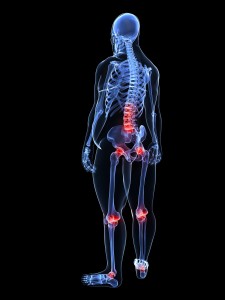What You Should Know About Obesity and Arthritis
 When talking about the effects of obesity, most people usually think of the obvious and most talked about related conditions: diabetes and heart disease. But obesity actually has a negative impact on nearly every body function, including the bones and joints. In this blog, let’s strive for a better understanding of arthritis – what it is, why it matters, what you can do about it, and the important connection between arthritis and obesity.
When talking about the effects of obesity, most people usually think of the obvious and most talked about related conditions: diabetes and heart disease. But obesity actually has a negative impact on nearly every body function, including the bones and joints. In this blog, let’s strive for a better understanding of arthritis – what it is, why it matters, what you can do about it, and the important connection between arthritis and obesity.
What Is It?
Osteoarthritis is the most common type of arthritis, affecting approximately 27 million Americans. It is characterized by the breakdown of cartilage – the flexible but tough connective tissue that covers the ends of bones at joints. In relationship to obesity, there’s a logical connection with osteoarthritis given that more weight placed on a joint causes more stress, ultimately leading to damage. Areas of particular concern for the severely overweight are knees and hips, which bear most of a person’s body weight. In addition, fat itself is an active tissue that creates and releases chemicals which can promote inflammation, a major factor in the pain associated with arthritis conditions.
Why Does It Matter?
- According to the Centers for Disease Control (CDC), 72 million Americans are obese, 50 million people have arthritis, and about one in three obese adults have arthritis.
- As the nation’s leading cause of disability, arthritis affects all ages.
- Contrary to popular belief, arthritis is not just one disease, but a term for more than 100 degenerative joint conditions that can affect the whole body, including organs.
- In some cases obesity raises the risk of getting certain types of arthritis, and in all cases, obesity makes arthritis worse. An osteoarthritis study partly funded by the Arthritis Foundation found that people who are obese are more likely to develop the advanced, end-stage disease requiring total joint replacement than those who are at a healthy weight.
- A CDC report in 2007 found that women were more likely to have both arthritis and obesity than arthritis by itself, and older age was a risk factor for a higher prevalence of both arthritis and obesity.
- According to a recent Mayo Clinic study, women with a history of obesity are at a higher risk of developing rheumatoid arthritis.
- Obesity prevalence is 54% higher among adults with arthritis compared to adults without arthritis.
What Can You Do?
Physicians (myself included) have been emphasizing the importance of maintaining a healthy body weight for many years. When it comes to obesity and arthritis, we’re concerned with the damaging effects on the joints and inflammation in the form of rheumatoid arthritis. Obese people with arthritis might have a difficult time losing weight because the chronic pain it causes can limit mobility and physical activity, a key component of weight loss. Low impact physical activities such as aquatic exercise, stationary cycling, or walking, may be good options for overweight people who suffer from arthritis. As always, talk to your doctor before beginning any exercise programs and be sure to discuss symptoms of arthritis such as pain and functional limitations so that your doctor can work with you to develop an appropriate treatment plan that doesn’t put you at further risk of injury.
If you suffer from an arthritis condition, are significantly overweight and are struggling to lose the weight with traditional dieting and exercise, the Lite & Smart Dimensions™ Weight Loss program might be right for you. Learn more here.






